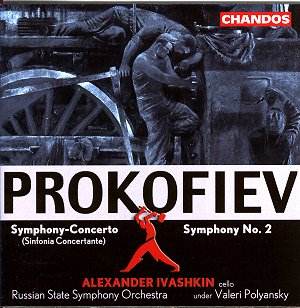Chandos’s previous Prokofiev series, recorded in the
80s with Neëme Järvi and the Royal Scottish National Orchestra,
is still probably the most recommendable complete cycle available. Chandos
now seem to feel the need to start again, the reason possibly being
that they are now using ‘authentically’ all-Russian forces. Whatever
the company’s motivation (or if indeed it is to be a complete cycle),
the results are impressively powerful, and the coupling stimulating
and generous.
The Second Symphony has never really gained
a firm foothold in the repertoire. It is often criticised excessively
by writers as ‘not a successful symphony, if only because of its lack
of cohesion and undisciplined substance’ (Robert Layton). Others see
it as setting out to shock Parisian audiences in the Twenties (as The
Rite of Spring had famously done a dozen years earlier), or just
plainly too loud and brash for its own good. It doesn’t help matters
that Prokofiev himself, having set out to write a symphony ‘made of
iron and steel’, then proceeded to judge it very harshly. Writing after
the premiere, he commented ‘Neither I nor the audience understood anything
in it. It was too thickly woven. There were too many layers of counterpoint
which degenerated into mere figuration’. This performance certainly
tries to make us understand the piece as not only a child of its time,
but a necessary development in its composer’s creative output. The short
opening movement is simply an explosion of violent dissonance, the most
unremittingly loud music he ever wrote, the Scythian Suite included.
But Polyansky teases out other elements, and tries to make us hear some
of Prokofiev’s sonata-exposition material, which is buried there somewhere.
He certainly doesn’t underplay the aggression – indeed, some of the
high, screaming trumpet lines sound more like a Stan Kenton arrangement
– but he seems determined to show us another face to the music. The
long second movement is a favourite Prokofiev structure, a theme
and variations, and puts the short opening movement into relief
(the whole bi-partite scheme is modelled on Beethoven’s Op.111 Piano
Sonata). Even here, the calm opening eventually gives way to an
intense climax, before subduing to a quiet coda. Polyansky is impressive
at judging the differing moods, and his orchestra support him with a
suitably Russian sound – rather reedy woodwind, a slightly ‘wobbly’
horn vibrato, and a slight edge to the well-drilled string sections.
The coupling is very apt, showing how the ‘enfant terrible’
mellowed into one of the most lyrical compositional voices of the 20th
Century. Normally known as the Sinfonia-Concertante, it is here
given its proper title of Symphony-Concerto (from the Russian
Simfonia-Kontsert). This is indeed more appropriate to the major
dimensions and sheer symphonic scale of the work. Written for, and in
close collaboration with, Rostropovich, the piece teems with memorable
ideas, and embodies at least three of Prokofiev’s four compositional
directions – classical, lyrical and motoric (toccata-like); the
fourth, modernist, is well represented by the Second Symphony!
Prokofiev does recycle some material from his earlier Cello Concerto,
but had in the intervening years, become a complete master of his craft.
The sheer beauty of sounds conjured up point to Romeo and Juliet
and the Fifth Symphony, and the piece, which has fared well on
disc, can receive no better advocacy than that of Alexander Ivashkin.
His sumptuous tone, impeccable tuning and fiery virtuosity are up there
with the best, and he is brilliantly supported by Polyansky, who sensitively
works with his soloist through the many shifts in tempo and mood.
The recording is well up to Chandos’s house standards,
with a only a hint of ‘in-your-face’ forward balance at the start of
the Symphony (this could, of course, be the music as much as
the recording). In any case, it is set in a suitable acoustic, and sounds
eminently truthful – indeed, the producer is Polyansky himself, who
presumably knew the sort of sound he wanted. The liner notes, by the
cellist on the disc, are concise and stimulating. Highly recommended.
Tony Haywood


